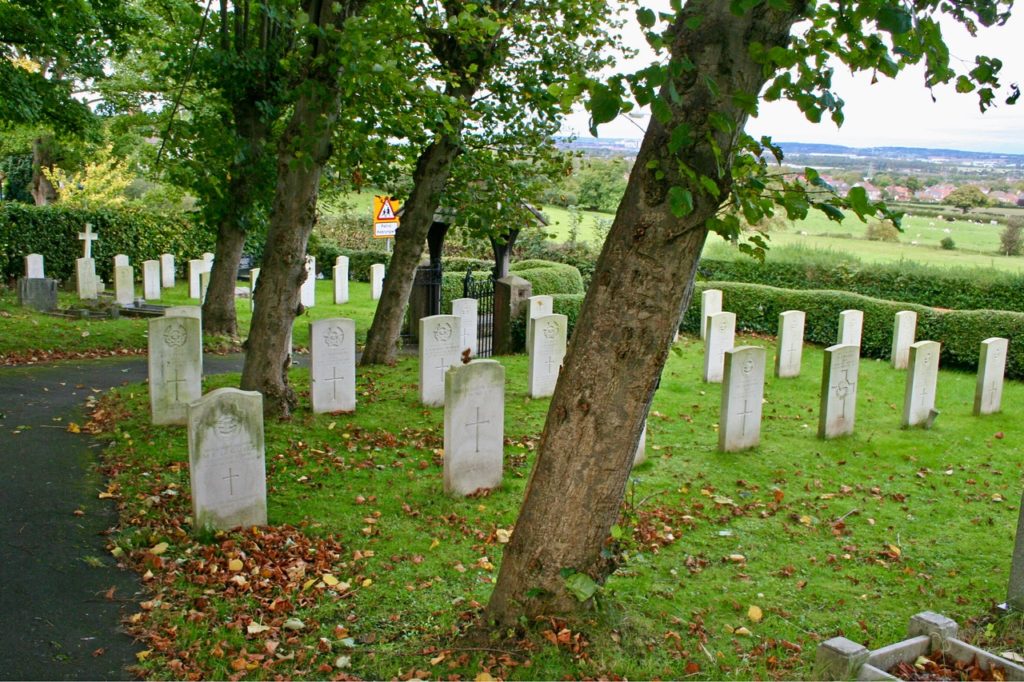
All are welcome to look round our churchyard but please take care! Paths may be uneven and slippery. Grass may conceal hazards such as stones and potholes. Gravestones and monuments may be loose and should not be leaned upon or climbed over. Branches may fall from trees in windy weather
There has been a church on this site since St Deiniol, a 6th Century Welsh saint, planted his staff here.
As you leave the church by the south (main) door you will see the large cedar of Lebanon tree to your right. These were introduced in the 17th Century, and most were planted from the 1740s onwards inspired by the words of Psalm 92: “The righteous will flourish like a palm tree, they will grow like a cedar of Lebanon, planted in the house of the Lord”.
Nearby is the bier house, built in 1906. Coffins were brought on a bier cart from people’s homes. The bier cart is now in the Gladstone memorial chapel in Church. Walk round the west side of the church under the large holly tree and take the rough path to your left. Follow the path along the boundary wall and you will come to the Gladstone family grave at the end
William Gladstone, the 19th century prime minister and his wife Catherine are buried at Westminster Abbey There is an interesting memorial to their youngest son, Herbert, a former Home Secretary and Governor General of South Africa.
Lt W.G.C. Gladstone, squire and grandson of the former prime minister, was killed in France in 1915 during the First World War. His was the last body to be returned to Britain for burial.
Re-join the main path behind the church and go down the hill. On your left is a sign to the Crimean War grave. Thomas Ryan was at the Charge of the Light Brigade in the Battle of Balaclava in 1854 He survived the war and lived to the good age of 88.
Continue down the middle of the three paths where they fork.
Near the bottom end of the middle path are the graves of airmen, most of whom were killed in training during the Second World War, They’re cared for by the Commonwealth War Graves Commission.
The lychgate dates from 1784 and was moved to this site when the churchyard was extended in 1912.
Return to the church and turn left around the east side to the front of the church where you will see the Boer War memorial cross (see separate information, available from the Church Office)
As you walk back to the church you will see on your right the grave of Walter Roberts, a conscientious objector who died of pneumonia after he was sent to work in a quarry at Dyce in Aberdeenshire in 1916. This led to questions in parliament and a change in the treatment of conscientious objectors. The inscription on his gravestone is from St Mark’s gospel.
The large oak tree was planted in 1911 to mark the coronation of King George V. There is an inscription on the wall nearby You may hear and see the jackdaws which nest in the tower
You will see many yew trees in this churchyard Yews may have been planted in churchyards as their long life was suggestive of eternity Another suggestion is that the poisonous foliage discouraged farmers and drovers from letting their animals into churchyards Yew branches were often used as a substitute for palms on Palm Sunday.
Part of the southeast corner of the churchyard is being managed as a wild flower area.
We hope you enjoy walking around our beautiful and peaceful churchyard.
Church Office 01244 534912 Hawarden.benefice@gmail.com
Gravestones are the property of the families that erected them. They have primary responsibility for their care However, memorials are located on church land and the church has a duty to manage the risks they present.
Some information about graves is held at Flintshire Record Office (next door to the Church in Rectory Lane) 01244 532364 www.flintshire.gov.uk Email: archives@flintshire.gov.uk
